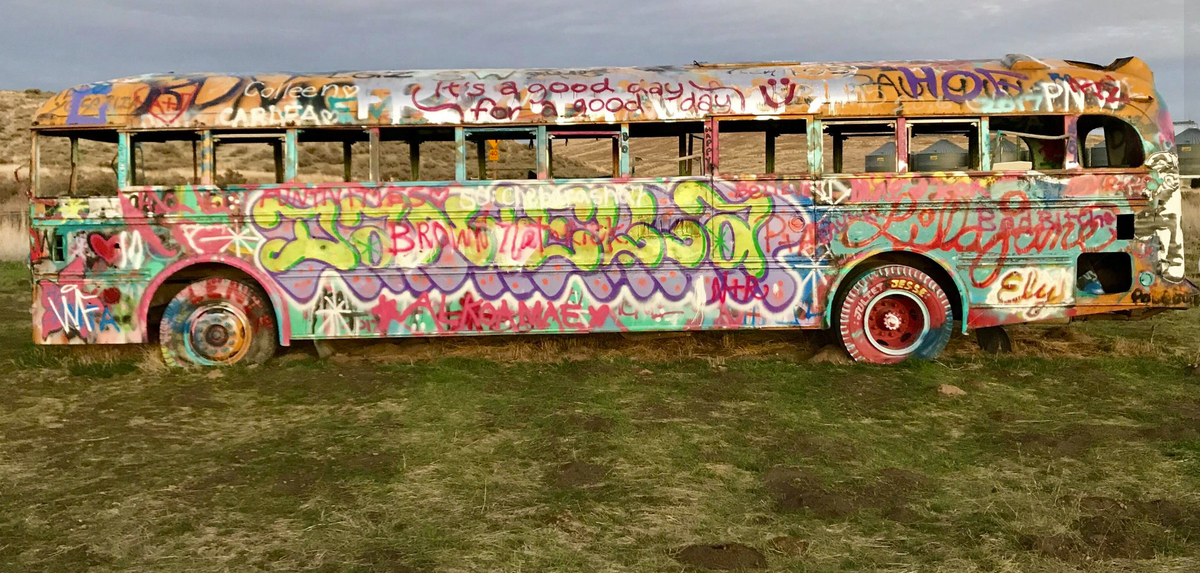Washtucna’s ‘Magic School Bus’ along Highway 261 has become a must-see quirky roadside attraction

Social media users around the world have called it many names – commonly, “The Magic School Bus,” sitting on the side of the road in the “middle of nowhere.”
“Just when I was getting sleepy,” one Instagram user wrote in 2020, “this came out! What a surprise.”
A surprise is exactly what the town of Washtucna, population 211, intended when they moved an abandoned 1955 Kenworth Pacific School Bus to the side of Highway 261 in 2018.
The bus – dubbed #thatNWbus by tourists – has risen to fame in and around Washington State for its colorful nature.
Lee Ann Blankenship, a Washtucna resident, remembers the bus in the 1980s, when it was still yellow, albeit a little rusty. Now, after countless decades sitting along the highway, the bus is littered with colorful graffiti – a bright beacon in the middle of rolling hills of grain.
According to the Washtucna Historical Museum, which owns the bus, it had been located on government-owned land along Highway 260 outside of Starbuck, Washington, for decades.
“I mean, so many of us that grew up around here, it was just a landmark.” Blankenship said.
The bus had once been used by a farmer, she said –it’s common for farmers to use old school buses to store harvesting supplies.
It was abandoned decades ago, and, because it was visible from the highway, #thatNWbus became a stop for tourists, who left their marks with paint (despite needing to jump a “barbed wire fence or two,” to reach it, locals said).
In 2017, the Department of Natural Resources, which owned the land the bus sat on, determined it to be a safety hazard, Blankenship said.
“They determined it more of a liability than a charming roadside attraction,” the museum said on its website.
Blankenship, who helped found the Washtucna museum, recalls getting called in “the middle of the night” – residents saying, “They’re taking our bus!”
The museum had less than a week, she said, to make the decision to intervene and save the bus.
The department collaborated with the museum to donate the bus and arrange its transportation to its present location, making it more accessible to visitors. The land the bus sits on today was donated in 2018 by Blankenship Farms.
In the six years since then, #thatNWbus has continued to be a favorite stop for those visiting Eastern Washington.
The museum describes the bus as “part-living guest book, part-art gallery.” It has more than 1,000 posts on Instagram, and almost 200 Google reviews.
Social media handles, wedding anniversaries, drawings, “I love you!” and “(Name) was here” combine with smiley faces to form the colorful mosaic. There is no school-bus yellow in sight.
There is also no steering wheel. No windows. No seats, rearview mirrors or headlights.
“I mean, it’s painted head to toe, front end to back end, inside out,” Blankenship said.
Some residents of the town look down on the bus for its colorful nature.
“Kind of like the gum wall in Seattle,” Blankenship said. “Some people were disgusted, others are like, ‘This is so cool!’ ”
No matter what, she said, “You drive by, it sticks out.”
The bus brings visitors to Washtucna, an area that, in recent decades, hasn’t seen many out-of-towners.
“Anybody who passes through town, we want to give them a reason to stop,” said Lloyd Stoess, a member of the museum’s board, who also owns a manufacturing business in town. Washtucna, he said, has “the big three”: a place to get gas, a place to eat and a place to use the restroom.
“And if you’ve got another thing, like the bus, that just gives them another reason to stop,” he said.
The town is on the main route between Seattle and Washington State University, Stoess said. It is also on the way to Palouse Falls. Since becoming the official state waterfall in 2014, Stoess said, traffic has “about quadrupled” in the area.
“(Washtucna) is not what it once was,” Blankenship said. “It’ll never be that again, but we’re still holding out hope to make it something pleasant for people to come through.”
Blankenship and the museum had plans of expanding in the area around the bus – in 2019, WSU made plans for an art park and learning trail to surround the bus, teaching visitors about the geological history of the area. The major challenge in bringing the plans to fruition, Blankenship said, is funding.
For now, #thatNWbus remains a lone, colorful attraction, catching drivers’ eyes from the side of state Route 261. The only thing that will be changing, the museum said, is its paint job.
The bus invites people, as Blankenship said, to put their marks on it – experiencing the “layers of common joy” it brings to the area.
“It represents a collective respect for this kind of art. I just hope people respect it as a way to express themselves.”